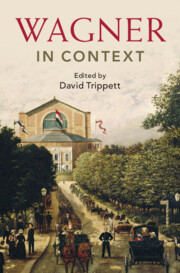Book contents
- Wagner in Context
- Composers in Context
- Wagner in Context
- Copyright page
- Contents
- Illustrations
- Musical Examples
- Contributors
- Acknowledgements
- Abbreviations
- Introduction
- I Place
- II People
- III Politics, Ideas, and Bodies
- IV Life, Language, and the Ancient World
- V Music and Performance
- Chapter 29 Orchestration
- Chapter 30 Wagner and Analysis: Siegfried and the Rheinmaidens
- Chapter 31 The Scene of Grand Opera
- Chapter 32 Wagner on the Move
- Chapter 33 Stage Technology
- Chapter 34 Historic Stagings: 1876–1976
- VI Reception
- Further Reading
- Select Bibliography
- Index
Chapter 33 - Stage Technology
from V - Music and Performance
Published online by Cambridge University Press: 14 March 2024
- Wagner in Context
- Composers in Context
- Wagner in Context
- Copyright page
- Contents
- Illustrations
- Musical Examples
- Contributors
- Acknowledgements
- Abbreviations
- Introduction
- I Place
- II People
- III Politics, Ideas, and Bodies
- IV Life, Language, and the Ancient World
- V Music and Performance
- Chapter 29 Orchestration
- Chapter 30 Wagner and Analysis: Siegfried and the Rheinmaidens
- Chapter 31 The Scene of Grand Opera
- Chapter 32 Wagner on the Move
- Chapter 33 Stage Technology
- Chapter 34 Historic Stagings: 1876–1976
- VI Reception
- Further Reading
- Select Bibliography
- Index
Summary
Since the inaugural Bayreuth Festival of 1876, Wagner has been widely considered an innovator of the illusionist stage who foreshadowed twentieth- and twenty-first-century immersive multimedia. Yet a sole focus on his stage-technological achievements glosses over many revealing ironies. Not only was Wagner deeply ambivalent about technological progress; but he conceived of his Gesamtkunstwerk as an aid to overcome what he perceived as the socio-culturally alienating effects of industrialisation. This chapter illuminates Wagner’s ultimately fraught strategy, in both theory and practice, to advance and simultaneously conceal his stage machinery. Although pushed to new extremes, Bayreuth’s stage-technical solutions for the particularly challenging Ring cycle were firmly based on contemporary practices; moreover, they fell far behind Wagner’s idealist visions. In the end, the inevitable technologisation of Wagner’s stage presented a critical predicament in his aspiration to outdo both opera and the machine.
Keywords
- Type
- Chapter
- Information
- Wagner in Context , pp. 331 - 339Publisher: Cambridge University PressPrint publication year: 2024

